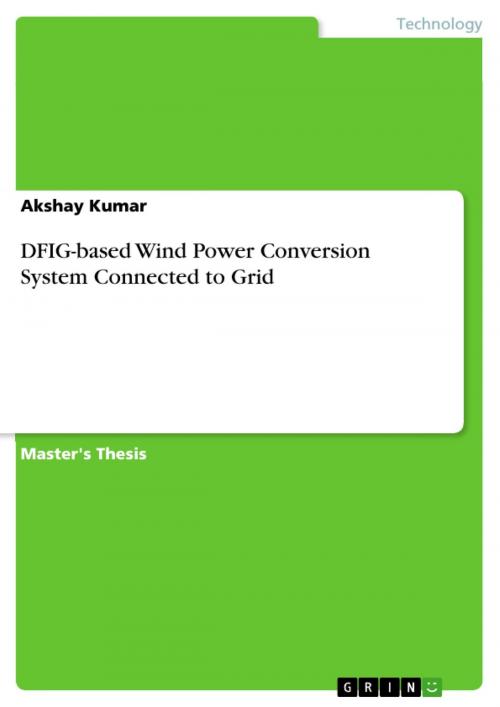DFIG-based Wind Power Conversion System Connected to Grid
Nonfiction, Science & Nature, Science, Physics, Energy| Author: | Akshay Kumar | ISBN: | 9783656720164 |
| Publisher: | GRIN Verlag | Publication: | August 14, 2014 |
| Imprint: | GRIN Verlag | Language: | English |
| Author: | Akshay Kumar |
| ISBN: | 9783656720164 |
| Publisher: | GRIN Verlag |
| Publication: | August 14, 2014 |
| Imprint: | GRIN Verlag |
| Language: | English |
Master's Thesis from the year 2014 in the subject Engineering - Power Engineering, grade: 7.8, Ajay Kumar Garg Engineering College, course: M.Tech, language: English, abstract: Wind generation has become the most important alternate energy source and has experienced increased progress in India during the past decade. While it has great potential as an alternative to less environmentally friendly energy sources, there are various technical challenges that cause wind to be considered negatively by many utilities. Wind energy conversion systems suffer from the fact that their real power generation is closely dependent on the local environmental conditions. The Doubly Fed Induction Generator (DFIG) based wind turbine with variable-speed variable-pitch control scheme is the most popular wind power generator in the wind power industry. This machine can be operated either in grid connected or standalone mode. In this thesis, a detailed electromechanical model of a DFIG-based wind turbine connected to power grid as well as separately operated wind turbine system with different sub-systems is developed in the MATLAB/SIMULINK environment and its equivalent generator and turbine control structure is realized. In this regard following configurations have been considered: •DFIG with Battery storage sub-system •DFIG with Buck-Boost converter •DFIG with transformer •DFIG with 3-winding transformer Addition of battery storage and buck-boost converter sub-systems into the system enables not only dispatching of generator power but also decreases the variability in their reactive power requirements. The full control over both active and reactive power is possible by the use of transformer between DFIG and rotor side converter. The steady state behavior of the overall wind turbine system is presented and the steady state reactive power ability of the DFIG is analyzed. It has been shown that major part of the reactive power should be supplied from rotor side converter to reduce the overall rating of the generator. The DFIG with above mentioned sub-systems is connected to grid. The total harmonic distortion analysis and efficiency are carried out. It is found that DFIG with transformer in between machine and rotor side converter has lowest THD (2.29%) and DFIG with 3-winding transformer has maximum efficiency (above 93%).
Akshay Kumar was born in Ghaziabad, India, in 1988. He received the B. Tech (Electrical and Electronics) degree from Ideal Institute of Technology, Ghaziabad(Affiliated to UPTU, Uttar Pradesh), in 2009 and, recently completed his M. Tech (Electrical Power and Energy Systems) from Ajay Kumar Garg Engineering College, Ghaziabad (affiliated to MTU, Uttar Pradesh). He worked in Industry and he has also teaching experience of more than 1 and half year in Engineering College. Published more than six technical papers in Conferences,natinal and international journals. His speciliztion area is Matlab (simpower), power quality, renewable energy sources.
Master's Thesis from the year 2014 in the subject Engineering - Power Engineering, grade: 7.8, Ajay Kumar Garg Engineering College, course: M.Tech, language: English, abstract: Wind generation has become the most important alternate energy source and has experienced increased progress in India during the past decade. While it has great potential as an alternative to less environmentally friendly energy sources, there are various technical challenges that cause wind to be considered negatively by many utilities. Wind energy conversion systems suffer from the fact that their real power generation is closely dependent on the local environmental conditions. The Doubly Fed Induction Generator (DFIG) based wind turbine with variable-speed variable-pitch control scheme is the most popular wind power generator in the wind power industry. This machine can be operated either in grid connected or standalone mode. In this thesis, a detailed electromechanical model of a DFIG-based wind turbine connected to power grid as well as separately operated wind turbine system with different sub-systems is developed in the MATLAB/SIMULINK environment and its equivalent generator and turbine control structure is realized. In this regard following configurations have been considered: •DFIG with Battery storage sub-system •DFIG with Buck-Boost converter •DFIG with transformer •DFIG with 3-winding transformer Addition of battery storage and buck-boost converter sub-systems into the system enables not only dispatching of generator power but also decreases the variability in their reactive power requirements. The full control over both active and reactive power is possible by the use of transformer between DFIG and rotor side converter. The steady state behavior of the overall wind turbine system is presented and the steady state reactive power ability of the DFIG is analyzed. It has been shown that major part of the reactive power should be supplied from rotor side converter to reduce the overall rating of the generator. The DFIG with above mentioned sub-systems is connected to grid. The total harmonic distortion analysis and efficiency are carried out. It is found that DFIG with transformer in between machine and rotor side converter has lowest THD (2.29%) and DFIG with 3-winding transformer has maximum efficiency (above 93%).
Akshay Kumar was born in Ghaziabad, India, in 1988. He received the B. Tech (Electrical and Electronics) degree from Ideal Institute of Technology, Ghaziabad(Affiliated to UPTU, Uttar Pradesh), in 2009 and, recently completed his M. Tech (Electrical Power and Energy Systems) from Ajay Kumar Garg Engineering College, Ghaziabad (affiliated to MTU, Uttar Pradesh). He worked in Industry and he has also teaching experience of more than 1 and half year in Engineering College. Published more than six technical papers in Conferences,natinal and international journals. His speciliztion area is Matlab (simpower), power quality, renewable energy sources.















